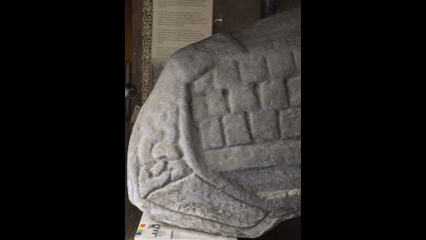MSc Heritage Visualisation School of Innovation & Technology
Katherine Mackenzie

Having studied History, with a focus on medieval Europe, at Glasgow University I was drawn to the MSc in Heritage Visualisation in order to continue exploring Scotland’s heritage while learning a host of new skills. I believed these skills would provide me with the practical knowledge to creatively tell the historical stories I had researched and loved, but not known how to effectively convey.
My particular historical interests lie in cultural, linguistic, and artistic heritage (including physical artwork, literature, music, and theatre). These areas fascinate me due to what they tell us about a society’s values and beliefs, and therefore how they help us to understand that society better.
The projects I took part in this year showcase my interests and aims, and I look forward to how digital heritage can continue to help us to engage with these heritage areas and, by consequence, improve our own appreciation of historical peoples and places.
Contact

legends and landscapes: an investigation into adapting folktales for location-based digital heritage narratives
Digital reproductions of heritage objects have often been perceived as lacking the authenticity and ‘aura’ carried by the original. While combating this loss has been investigated, particularly concerning physical objects, written and oral literature has thus far been neglected. This research aims to address this by exploring how folktales can be adapted well to the digital realm, particularly through using a creative response to augment authenticity and aura and through locative technologies to connect the folktale to the landscape and culture it developed within. To achieve this, a mobile application has been created which utilises GPS technology to lead the user on a walk through the Northumbrian countryside while engaging with an interactive narrative, audio narration and 2D artwork. This presents the folktale, ‘The Laidley Worm of Spindlestone Heugh’, in a manner that harnesses digital technology while maintaining the authenticity of a folktale. Testing revealed that aura and authenticity were benefited by this approach and locative technology particularly helped users connect to the folktale and its environment. Therefore, a method for effectively reproducing folktales for the digital realm has been created, which can be used and built upon in the future.



hush-hush hogbacks: exploring govan’s medieval monuments through interactive visualisation
Not much can be said with certainty about the hogback. They are early-medieval monuments found across northern England and southern Scotland, with the largest being found here, in Govan, Glasgow. But why were they made? By whom? What do they represent? Supposedly they are of Scandinavian heritage, yet there are no examples in Scandinavia; presumably they are funerary monuments but without human remains; they are carefully designed yet of unclear archetype. With no definite answers, not only were these puzzles intriguing to the Govan Pebbles team, but they also highlighted the challenge of conveying archaeological uncertainty to the public.
We created an interactive visualisation in Unity to address these issues, where we introduced the hogbacks and presented three theories of what they might represent, employing a mixed-media approach of 3D models, videos, text, and audio. The user is asked to employ critical thinking to choose between these, illustrating the open-ended nature of archaeological research. The visualisation finishes with a video discussion of what this uncertainty means for archaeology at Govan and beyond and therefore, we simultaneously address the fascination of the stones and the deeper question of what it means to ‘know’ in archaeology.





modelling the kelvingrove art gallery and museum
One of the major projects in the first semester was create a detailed model the front of Kelvingrove Art Gallery and Museum and a block-out (rough draft) of the remainder of the building. This included modelling and texturing, and setting up lighting, cameras and animations – all of which were new skills to me. Although a challenging project, it was rewarding to learn so many new skills and see the building gradually take shape before me. I look forward to building on this foundation with further 3D modelling in the future!







